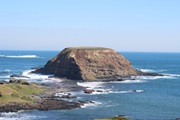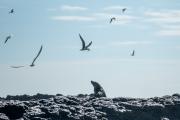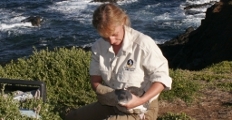Taking action to find and remove Phillip Island fox threat
Phillip Island Nature Parks has taken swift action in response to evidence of a fox on the island for the first time in seven years – and is asking for the community’s help by reporting any sightings.
The Nature Parks is responding to a report of a fox on Phillip Island (Millowl) after a number of chickens were killed on a local property earlier this month. Prints and a scat were found initially, before infrared surveillance cameras captured a photo of a fox.
Stuart Murphy, Vertebrate Pest Program Manager at the Nature Parks, said traps have been deployed, and night-time surveys and detection dog surveys are being undertaken at the site and in surrounding areas to locate and remove the fox. The scat and other samples will be undergoing genotyping to determine the sex and obtain a DNA profile of the fox for future reference.
“Foxes are the greatest land-based threat to little penguins on Phillip Island, so we’ve been monitoring the Summerland Peninsula regularly to ensure the safety of the colony and thankfully there has been no evidence of fox presence in the area to date,” he said.
Foxes are also one of the primary causes of extinction for many of our native species, and they can pose a threat to livestock and domestic pets.
“We’re asking for the community’s help by reporting any fox sightings on Phillip Island to 0419 369 365,” Mr Murphy said.
“A combined effort between the Nature Parks and the community will help us to capture this fox – and remove the threat it poses to our little penguins, local wildlife and livestock – as quickly as possible.”
Phillip Island was declared fox-free in 2017, after around 25 years of dedicated effort. Removing the threat of foxes has always been a priority of the Nature Parks, with ongoing measures including a fox control buffer zone on the mainland to reduce the threat of reinvasion, the use of detection dogs, night vision equipment, and ensuring the Foxcam on the Phillip Island bridge remains operational.
“While we don’t know how the fox arrived on Phillip Island, we do know the Foxcam is operating well and would have detected a fox crossing the bridge from the mainland,” Mr Murphy said.
“Foxes have been known to swim significant distances in search of new territory and food, and it wouldn’t have been impossible for a fox to swim between San Remo and Phillip Island.”





















